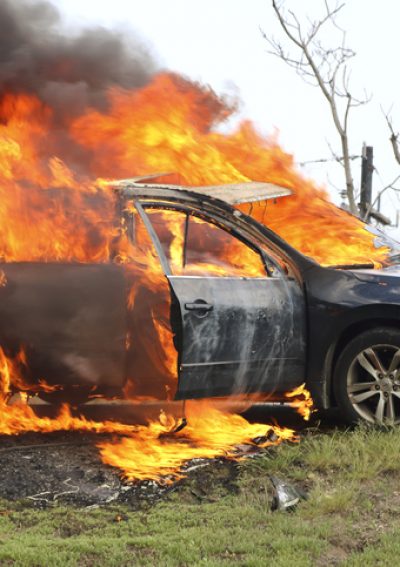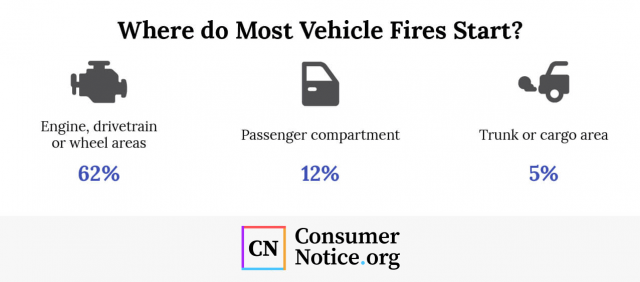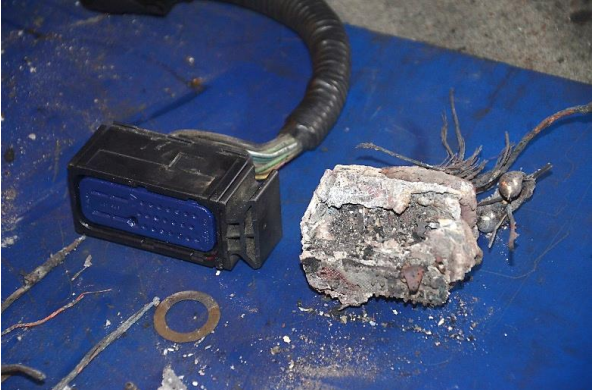Highway Vehicle Fires
There are more than 170,000 highway vehicle fires in the United States every year. While less frequent than other types of fires, vehicle fires are more likely to result in fatalities. Most of these fires begin with problems in the engine, drivetrain or wheel areas. They may also be caused by a faulty design or defective parts.

There are more than 19 vehicle fires every hour in the United States. They account for 1 in every 8 calls that fire departments respond to.
Vehicle fires kill nearly seven people every week. They cause another 1,300 injuries and $1.1 billion in property damage every year. Passenger cars and trucks are responsible for 83 percent of all highway vehicle fires, according to the U.S. Fire Administration.
What Are the Main Causes of Vehicle Fires?
More than a third are the result of some unintentional action, either careless behavior or accidents. And nearly a quarter are caused by equipment failure or a heat source in the car or truck.
Heat from powered equipment, the engine or drivetrain, and sparks from friction or electrical arcs account for 2 in 3 vehicle fires. Smoking or some other type of open flame accounts for 7 percent of fires.

Only about 5 percent of car fires result from a collision. But those account for 6 in 10 of all fatal vehicle fires. Less than 2 percent start in the fuel tank or lines.
Keeping your car in good working order and avoiding open flames or flammable items in the passenger compartment are among the best ways to prevent a car fire.
Major Recalls Due to Vehicle Fire Risks
Defective parts are responsible for only a fraction of vehicle fires, but they have resulted in hundreds of deaths and put millions of consumers at risk. Since 2012, automakers have recalled more than 9.5 million cars due to faulty parts or other design issues that could cause a fire.
Kia & Hyundai Recalls for Engine Fires
Kia and Hyundai have recalled 2.3 million vehicles since 2015 due to engine fire risks. Nearly 3 million of the companies’ vehicles face a federal investigation over potential fire dangers.
The National Highway Traffic Safety Administration is investigating engine fire risks in 10 different Kia and Hyundai models built between the 2010 and 2016 model years.
| MAKE | MODEL | MODEL YEARS |
|---|---|---|
| KIA | Soul | 2010-2016 |
| Optima Optima Hybrid Sorento | 2011-2014 | |
| Sportage | 2011-2012 | |
| HYUNDAI | Sonata Sonata Hybrid Santa Fe | 2011-2014 |
| Sante Fe Sport | 2013-2014 | |
| Tucson | 2011-2013 |
The agency has documented 3,125 fires resulting in 103 injuries and at least one death as of April 2019, according to Car and Driver. Kia and Hyundai fires are blamed on two problems. Some vehicles have defective parts that leave metal shavings in oil passages inside the engines. The engines can seize and start a fire.
Other recalled vehicles have an oil pan leak that may cause fires.
Ford Plagued with Millions of Recalled Vehicles over Fire Risks
Ford has issued a long series of vehicle fire risk-related recalls since the 1990s that have affected millions of cars and light trucks. In 2018, Ford issued two recalls for two completely different fire risks.
In September 2018, the company recalled 2 million F-150s in North America because of a fire risk with the trucks’ seatbelts. The belt’s pretensioner sets off an explosive charge to lock the belt in place during a crash. Ford received 23 reports of smoke or fire from the devices. There were no reports of injuries before the recall.
In December 2018, Ford recalled 874,000 full-sized pickup trucks because corroded engine block heaters caused at least three fires. No injuries were reported ahead of the recall. The company had to recall 327,000 of those trucks a second time in April 2019 — the fix the company had used for the heater block problem caused damage to other wiring.
Recalled Ford Triggered $100 Million Fire Aboard a Ship
A recalled Ford SUV was responsible for a $100 million fire aboard a transport ship in 2015, according to the National Transportation Safety Board. The Vehicle Carrier Courage was transporting vehicles including those belonging to U.S. military families returning from Europe, when a fire broke out below decks, destroying $90 million in cargo and causing $10 million damage to the ship.
The NTSB traced the source of the fire to a 2002 Ford Escape. The truck was part of a recall of 2001 through 2004 Escapes and Mazda Tributes which shared many of the same components. Brake fluid leaking from the master cylinder cap could flow onto a wiring harness and cause a fire.

Source: National Transportation Safety Board, July 17, 2017
The SUV’s owner had been stationed overseas for several years and had never been notified of the recall.
Fires from Jeep’s Plastic Gas Tanks Killed 75 People
Jeep spent years fighting consumer advocate and government calls to recall SUVs linked to fiery deaths and injuries. The company relented in 2013, recalling 1.56 million 2002 to 2007 Liberty SUVs and 1993 to 2004 Grand Cherokees. But problems continued for years after.
The SUVs had plastic gas tanks installed behind the rear bumper. They could rupture and explode in rear-end collisions. The National Highway Traffic Safety Administration reported 75 deaths and 58 injuries in 90 crashes.
The agency recommended that Jeep bolt a metal plate under the tanks for added protection. Jeep instead opted to install a company-made trailer hitch, claiming it would protect vehicle occupants. NHTSA accepted the modification but vehicle safety advocates continued to question whether it protected the gas tanks.
Are Electric Cars More Likely to Catch Fire than Gas-Powered Cars?
Electric cars are still too new and make up too small a percentage of all vehicles for safety experts to accurately how they compare to gasoline-powered cars when it comes to fire risks.
Tesla, the most high-profile electric car maker, claims gas-powered cars are 11 times more likely to catch fire than its vehicles. The company bases this measure on miles traveled.
Tesla says there have been five Tesla vehicle fires for every billion miles driven, while records show 55 gasoline-powered car fires in that same distance.
But Teslas make up just one-tenth of 1 percent of the 247 million vehicles on the road in the United States, so it is hard to get an accurate measure of fire risks. This will likely change as electric vehicles make up a larger percentage of traffic.
Water Damage May Trigger Electric Vehicle Fires
Flooding during Hurricane Sandy started an electrical fire that destroyed 16 Fisker Karma luxury electric cars awaiting delivery to dealers from a port in New Jersey.
The company said the vehicles were submerged under 5 to 8 feet of sea water for several hours. The saltwater caused corrosion leading to a fire in an electrical component in one of the cars. Hurricane winds spread it to surrounding vehicles.
Hurricane Sandy also caused similar fires in at least three Toyota Prius hybrids on the Newark, New Jersey docks.
Electric Vehicles May Catch Fire Hours After a Crash
Electric vehicles use lithium ion batteries, the same technology that powers laptop computers, smartphones and hundreds of other devices. Because of the way they are designed, they can catch fire or explode if they are damaged. This means they may not catch fire until hours after a collision.
In electric vehicle fires, the batteries can burn at 5,000 degrees and still deliver electric shocks of up to 400 volts, according to the U.S. Fire Administration.
The federal agency advises that electric vehicle fires may reignite as long as 24 hours after the first blaze is put out. It also recommends that once the electric vehicle is towed, it should be stored at least 50 feet from other cars, buildings or combustible items.
What to Do If Your Car Catches Fire
Crashes can lead to car fires, but most fires are due to fuel or electrical systems in the car. Routine maintenance and your own personal inspection around your car can prevent your car from catching fire.
- Broken or loose hoses
- Cracked or loose wiring
- Fuses that keep blowing
- Loose or missing oil cap
- Loud sounds from the exhaust
- Rapid changes in fuel levels or engine temperature
- Spilled or leaking oil under your car
- Wiring with exposed metal
Because vehicles are loaded with flammable or explosive fluids and fuel, vehicle fires can spread quickly. It is important to remain calm but react quickly. Fires are likely to start while you are driving, so it’s important to remain aware of traffic around you as you pull to safety and get out of the car.
- Turn off the ignition
- Get yourself and your passengers at least 100 feet away from the car
- If in a garage, exit immediately
- Be aware of traffic around you as you escape
- Be aware that an explosion can send metal and other debris flying over a great distance
- Call 911 only after you reach a safe distance
- Tell the 911 operator the exact location of the fire including whether it’s on the roadside or in a parking garage
- Do not attempt to return to the vehicle
- If you choose to use a fire extinguisher, remain at a safe distance and use only extinguishers for Class B and Class C fires
Fire safety experts recommend that you should not attempt to fight the fire yourself. They also recommend that professional firefighters use extreme caution in fighting vehicle fires.
You should never open the hood, trunk or doors after a car is burning. Doing so can flood the compartment with fresh air, causing the fire to get worse. It could also expose you to serious injuries.
After the fire is put out, you’ll need to talk to your insurance agent. Ask firefighters if it’s safe to approach the vehicle to take pictures of the damage and retrieve any personal items.
Gather names and phone numbers from witnesses and contact numbers for police officers who respond. You’ll need these for your insurance claim.
Even if it was only a minor fire, you should not attempt to drive the vehicle. Have it towed and inspected before restarting the engine. An inspection may be able to determine the exact cause of the fire. If it is a manufacturing defect, that may be important if you decide to file a vehicle fire lawsuit.
30 Cited Research Articles
Consumernotice.org adheres to the highest ethical standards for content production and references only credible sources of information, including government reports, interviews with experts, highly regarded nonprofit organizations, peer-reviewed journals, court records and academic organizations. You can learn more about our dedication to relevance, accuracy and transparency by reading our editorial policy.
- Atiyeh, C. (2019, April 5). NHTSA Investigating Three Million Hyundai and Kia Vehicles for Fires. Car and Driver. Retrieved from https://www.caranddriver.com/news/a27053460/nhtsa-investigation-hyundai-kia-fires/
- Bartlett, J.S. (2018, December 21). Ford Recalls Full-Sized Pickup Trucks Due to Engine Fire Risk. Consumer Reports. Retrieved from https://www.consumerreports.org/car-recalls-defects/ford-recalls-full-sized-pickup-trucks-due-to-engine-fire-risk/
- Callaway, J. (2019, February 28). Dozens of Drivers Take Kia & Hyundai to Court Over Spontaneous Vehicle Fires. WFTS-TV. Retrieved from https://www.abcactionnews.com/news/local-news/up-in-flames/dozens-of-drivers-take-kia-hyundai-to-court-over-spontaneous-vehicle-fires
- CBS News. (2019, February 28). Hyundai, Kia Recall Over 500,000 Vehicles Due to Engine Fire Risk. Retrieved from https://www.cbsnews.com/news/hyundai-kia-recall-over-500000-vehicles-due-to-engine-fire-risk/
- Center for Auto Safety. (n.d.). Ford Cruise Control Deactivation Switch Fires. Retrieved from https://www.autosafety.org/category/vehicle_fires/ford_cruise_control_deactivation_switch_fires/
- Center for Auto Safety. (n.d.). Kia and Hyundai Non-Crash Fires. Retrieved from https://www.autosafety.org/kia-and-hyundai-non-crash-fires/
- Davies, A. (2013, November 11). One Statistic Shows Why Everyone Needs to Relax About the Recent Tesla Fires. Business Insider. Retrieved from https://www.businessinsider.com/17-cars-catch-on-fire-every-hour-in-the-us-2013-11
- Federal Emergency Management Agency. (2013, August). Vehicle Fires; What You Need to Know. U.S. Fire Administration. Retrieved from https://www.usfa.fema.gov/downloads/pdf/publications/fa-243.pdf
- Garthwaits, J. (2012, November 2). Mystery at Port Newark: Why Did 17 Plug-In Cars Burn? The New York Times. Retrieved from https://wheels.blogs.nytimes.com/2012/11/02/mystery-at-port-newark-why-did-17-plug-in-cars-burn/
- Hincha-Ownby, M. (2012, May 31). The World’s Most Famous Explosive Cars. Mother Nature Network. Retrieved from https://www.treehugger.com/the-worlds-most-famous-explosive-cars-4863775
- Isidore, C. (2018, May 17). Are Electric Cars more Likely to Catch Fire? CNN Business. Retrieved from https://money.cnn.com/2018/05/17/news/companies/electric-car-fire-risk/index.html
- Jensen C. and Jensen C. (2019, January 2). Sergio Marchionne: Oddly Honored Despite Fighting Deadly Jeep Recall. Forbes. Retrieved from https://www.forbes.com/sites/jensen/2019/01/02/sergio-marchionne-oddly-honored-despite-fighting-deadly-jeep-recall/#3e42f6574426
- Krisher, T. (2019, February 28). Hyundai, Kia Recall Over 500K Vehicles as Fire Risk Spreads. Associated Press/U.S. News and World Report. Retrieved from https://www.usnews.com/news/best-states/michigan/articles/2019-02-28/hyundai-kia-recalls-over-500k-vehicles-as-fire-risk-spreads
- Layson, G. (2019, April 10). Ford Recalls F-150, Super Duty Trucks a Second Time for Fire Risk. Automotive News. Retrieved from https://www.autonews.com/regulation-safety/ford-recalls-f-150-super-duty-trucks-second-time-fire-risk
- Marchitelli, R. (2019, March 25). “We Would Have Been Dead”: Father Outraged After Engine Puts Family at Risk. CBC News. Retrieved from https://www.cbc.ca/news/business/father-outraged-after-engine-fire-puts-family-at-risk-1.5064230
- Marchitelli, R. and Komnenic, A. (2019, July 8). Mother Who Watched Son Burn to Death in SUV Fire Joins Calls for Answers from Kia, Hyundai. CBC News. Retrieved from https://www.cbc.ca/news/business/calls-for-answers-from-hyundai-kia-following-recalls-1.5200078
- National Fire Protection Association. (n.d.). Vehicles. Retrieved from https://web.archive.org/web/20181230113752/https://www.nfpa.org/public-education/by-topic/property-type-and-vehicles/vehicles
- National Highway Traffic Safety Administration. (2014, November 14). ODI Resume; Investigation No. EA 12-005. Retrieved from https://static.nhtsa.gov/odi/inv/2012/INCLA-EA12005-9765.PDF
- National Transportation Safety Board. (2017, July 17). Marine Accident Brief; Fire Aboard Vehicle Carrier Courage. Retrieved from: https://www.ntsb.gov/investigations/AccidentReports/Reports/MAB1724.pdf
- New York State Homeland Security and Emergency Services. (n.d.). Chrysler Agrees to Recall 2.7 Million Jeeps to Fix Potential Fire Flaw. Retrieved from http://www.dhses.ny.gov/ofpc/alerts-bulletins/safety/text/2013/20130087.cfm
- Plungis, J. (2019, April 1). NHTSA Opens New Probes Into Hyundai and Kia Vehicle Fires. Consumer Reports. Retrieved from https://www.consumerreports.org/car-safety/nhtsa-opens-new-probes-into-hyundai-kia-vehicle-fires/
- Shepardson, D. (2018, March 15). Georgia Supreme Court Upholds $40 Million Fatal Jeep Fire Award. Reuters. Retrieved from https://www.reuters.com/article/us-fiatchrysler-verdict/georgia-supreme-court-upholds-40-million-fatal-jeep-fire-award-idUSKCN1GR3IU
- Shepardson, D. (2018, September 6). Ford Recalls Two Million Trucks Over Seat Belt Fire Risk. Reuters. Retrieved from https://www.reuters.com/article/us-ford-motor-recall/ford-recalls-2-million-trucks-to-address-seat-belt-fire-concerns-idUSKCN1LM1OA
- State Farm Insurance. (n.d.). Car Fire: What to do if it Happens to You. Retrieved from https://www.statefarm.com/simple-insights/auto-and-vehicles/car-fire-what-to-do-if-it-happens-to-you
- U.S. Bureau of Transportation Statistics. (n.d.). Number of U.S. Aircraft, Vehicles, Vessels, and Other Conveyances. Retrieved from https://www.bts.gov/content/number-us-aircraft-vehicles-vessels-and-other-conveyances
- U.S. Court of Appeals, Fifth District. (2018, November 26). Smith v. Chrysler Group, Appeal from U.S. District Court, Eastern Dist. of Texas. No. 17-40901. Retrieved from http://www.ca5.uscourts.gov/opinions/pub/17/17-40901-CV0.pdf
- U.S. Fire Administration. (2018, July). Highway Vehicle Fires (2014-2016). National Fire Data Center. Retrieved from https://www.usfa.fema.gov/downloads/pdf/statistics/v19i2.pdf
- U.S. Senate Judiciary Committee. (2013, November 7). Statement of Clarence M. Ditlow, Executive Director, Center for Auto Safety. Retrieved from https://www.judiciary.senate.gov/imo/media/doc/11-7-13DitlowTestimony.pdf
- Valdes-Dapena, P. (2012, January 16). 89,000 Mini Coopers Recalled for Fire Risk. CNN Money. Retrieved from https://money.cnn.com/2012/01/16/autos/mini_cooper_recall/index.htm?iid=HP_River
- Yarro, J. (2013, October 4). Elon Musk: Here’s Why that Model S Caught on Fire. Business Insider. Retrieved from https://www.businessinsider.com/model-s-fire-elon-musk-2013-10
Calling this number connects you with a Consumer Notice, LLC representative. We will direct you to one of our trusted legal partners for a free case review.
Consumer Notice, LLC's trusted legal partners support the organization's mission to keep people safe from dangerous drugs and medical devices. For more information, visit our partners page.
844-420-1914